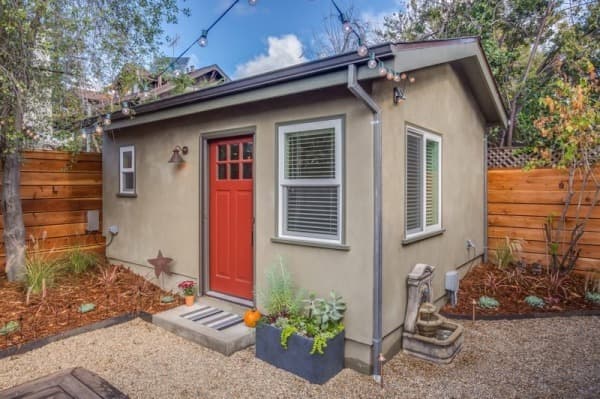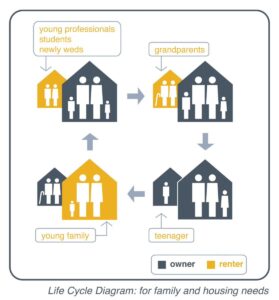
News
By Jeri Mintzer, October 15, 2025
We’re short 4.7 million homes. Our approach to housing aims to build more homes in the right places at the right price so that everyone can live in a community that supports them at every stage of life.
And when we say more housing, we mean more types of homes. In this series of explainer blogs, we’re taking a closer look at how, in addition to focusing on supply, smart growth strategies on type, place, and price are essential to solving the housing crisis and creating the types of homes and communities that allow people to stay, grow, and thrive.
Why focusing on housing type is part of the solution
 Most people think of housing as either a house or an apartment—but there are so many types of housing in between, and phases in our lives that we need them. Especially at a time when housing is so expensive, being able to choose the type of housing you live in is more important than ever. Young families are looking to stay in their hometown, close to grandparents and siblings, but “starter homes” are out of reach. A townhouse or larger apartment would be a better option, but only a few exist. A retired couple would like to stay in their home, but there is just too much space, and their tax bill is rising. Converting their basement into an apartment would be a huge help and offer a place to call home for a graduate student at the nearby college.
Most people think of housing as either a house or an apartment—but there are so many types of housing in between, and phases in our lives that we need them. Especially at a time when housing is so expensive, being able to choose the type of housing you live in is more important than ever. Young families are looking to stay in their hometown, close to grandparents and siblings, but “starter homes” are out of reach. A townhouse or larger apartment would be a better option, but only a few exist. A retired couple would like to stay in their home, but there is just too much space, and their tax bill is rising. Converting their basement into an apartment would be a huge help and offer a place to call home for a graduate student at the nearby college.
Unfortunately, outdated rules continue to make it difficult to build anything other than single-family homes on large lots in most neighborhoods. To address the housing crisis, we need more choices in the types and sizes of homes in more places and at a range of price points. We should be growing our communities in ways that make them work for more people and strengthen the economy. That means building a wider variety of housing options that meet the needs of diverse households.
Without these options, more of these single-family homes on larger lots keep getting built, and they’re being built further from jobs and other regular destinations. Because of the current system, we’re reducing options. This means that people are being left with no choice but to spend more on housing, spend more time commuting, leaving their needs unmet.
So, what types of housing should we be encouraging?
When people say that we should get rid of single-family only housing, they don’t mean that we should simply do away with these homes. We do mean that we should allow for more diversity of housing at different sizes, price points, and configurations, so people can find a home in places that best meet their needs. There are many types of housing that fall in between the classic single-family home and the high-rise apartment buildings of big cities. These types are often smaller-scale and often blend into existing neighborhoods. They can also fill in the underutilized spaces within communities or simply be built differently to more quickly and efficiently provide the homes we desperately need. A few key types include:
1. Accessory Dwelling Units (ADUs)
- What they are: Backyard cottages, garage apartments, basement units—a range of small homes that share a lot with a main house. Take a walk around your community; there are probably great examples of existing and historic ADUs.
- Why they matter: These smaller units generally rent for lower prices due to the smaller square footage. This makes them great for aging parents, grown kids, caregivers, single people, those just starting out in a career—or just helping homeowners afford their mortgage by having an additional space that can be rented out to generate income.
- Example: California made ADUs legal statewide and has seen a surge in new units.
2. Missing Middle Housing
- What it is: Duplexes, fourplexes, courtyard apartments, cottage clusters—smaller homes that fit into walkable neighborhoods.
- Why it matters: These homes are more affordable, use less land, and blend into existing neighborhoods.
- Example: Oregon’s HB 2001 legalized middle housing across most cities in the state.
3. Tiny Houses & Cottage Courts
- What they are: Standalone homes that are generally between 400-to 1,000 sq ft—think super-compact but livable.
- Why they matter: They’re low-cost, quick to build, and can add density without big buildings.
- Example: Dover, NH built a whole village of tiny homes for transitional housing.
4. Manufactured + Off-Site Built Housing
- What they are: Factory-built homes that get delivered to a lot and anchored in place.
- Why they matter: They're usually faster and cheaper to build than site-built housing since they are built in a factory.
5. Single Room Occupancy + Office-to-Housing Conversions
- What they are: Single-room occupancy units (with shared kitchens/baths) and converted office buildings.
- Why they matter: These are some of the fastest and cheapest ways to create deeply affordable housing, especially when retrofitting existing underutilized buildings.
- Forward-thinking: Office conversions are still catching on—but with the right zoning, they could help big time.
6. Reusing underutilized space for housing
- What it is: Turning underused malls, parking lots, or big-box store sites into new housing.
- Why it matters: These places already have roads, utilities, and jobs nearby—we just need to let housing in.
- Example: East Billings, MT used a form-based code to revitalize an industrial area into mixed-use housing.
How we’ll do this work
To meet the demand for more and different types of housing, communities must reform their outdated rules that limit what can be built. For example, most zoning codes in suburban areas don’t allow mixed-use, multifamily, or anything but single-family homes and sprawling car-centric development. Even more common are requirements like the number of parking spaces, how far homes must be set back from the road, and outright bans on different types of housing. The result is that even when townhomes or a ‘granny flat’ might seem possible, there are additional hoops to jump through—complex rules and processes to follow that add delays and costs. For example, duplexes might be permitted, but only with a special exception. Or, mixed-use buildings may technically be allowed but not explicitly defined, leading to requirements for additional parking spaces that make the project prohibitively expensive. These barriers too often prevent new housing from being built, or make it so expensive that it fails to create units that are affordable to those who need them most.
|
Type of Housing |
Zoning barrier |
Solution |
|
Accessory Dwelling Units (ADUs) |
Requirements for extra parking or owner occupancy; Unnecessary regulatory hoops or flat-out bans |
Allow ADUs by right in every residential neighborhood, remove parking and owner-occupancy requirements |
|
Missing Middle Housing |
Usually banned in single-family zones or allowed only with special approval |
Legalize middle housing by right and shift toward form-based standards |
|
Tiny Houses & Cottage Courts |
Most cities don’t know how to allow them—too small or don’t align with standard zoning |
Create zoning categories that recognize small-lot and tiny home development and allow Tiny Houses by right |
|
Manufactured + Off-Site Built Housing |
Often excluded from residential zones or subject to stricter design rules |
Treat manufactured homes like any other home—especially in areas where affordability is the goal |
|
Single Room Occupancy + Office-to-Housing Conversions |
Minimum unit sizes, parking requirements, or outright bans on shared housing |
Allow smaller units and shared living by right in commercial/mixed-use zones |
|
Transforming Suburbia |
Most suburban zoning codes don’t allow mixed-use, multifamily, or anything but car-centric development |
Use form-based overlays to allow housing and walkable design in these areas |
What work we’ve done on type in the past
Smart Growth America works with communities across the U.S. to help ensure we’re addressing the nation’s housing shortage by building more types of housing. We provide direct support to local governments and community-based organizations, advocate for reformed land use policies and financing arrangements, and conduct research and thought leadership on emerging trends.
Our recent work has included:
- Demonstrating that housing in walkable places is in higher demand, and those places tend to offer more types of housing in our Foot Traffic Ahead 2023 report.
- A series on parking minimums—how they are a barrier to housing development, and what can be done to change it.
- Explaining the connection between smart growth and the abundance movement.
- Sharing powerful policy change on missing middle housing at the local level.
Related News

© 2025 Smart Growth America. All rights reserved
Site By3Lane Marketing
























